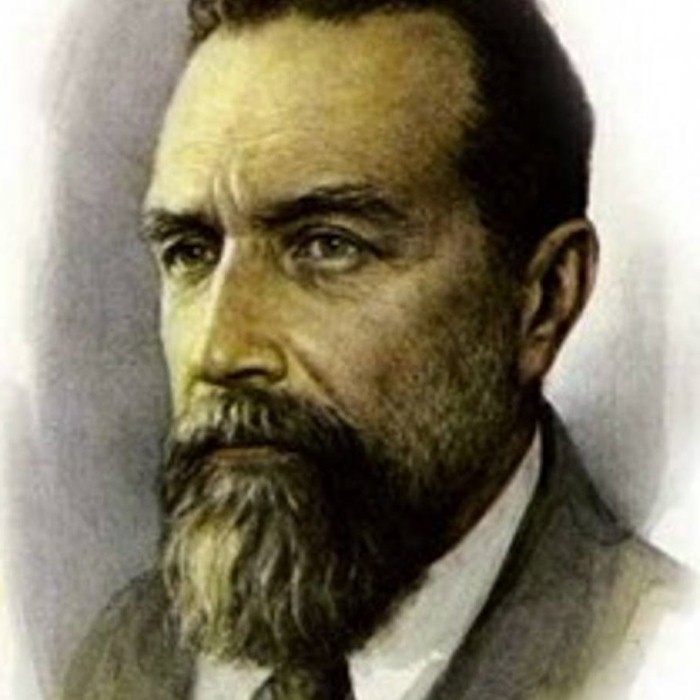Members
1 Male
Origin
 Russian
Russian
Genre
 Composer
Composer
Style
Classical
Mood
---
Born
1 Male
Origin
Genre
Style
Classical
Mood
---
Born
1881
Active ---
![]() 1950
1950
Cutout![]()
Alternate Name
Nikolai Miaskovsky
No loved tracks found...
Artist Biography
Available in:
Nikolai Yakovlevich Myaskovsky or Miaskovsky or Miaskowsky (Russian: Никола́й Я́ковлевич Мяско́вский ( 20 April 1881 – 8 August 1950 ) was a Russian and Soviet composer. He is sometimes referred to as the "Father of the Soviet Symphony". Myaskovsky was awarded the Stalin Prize five times, more than any other composer.
Myaskovsky was born in Modlin Fortress, near Warsaw, Congress Poland, Russian Empire, the son of an engineer officer in the Russian army. After the death of his mother the family was brought up by his father's sister, Yelikonida Konstantinovna Myaskovskaya, who had been a singer at the Saint Petersburg Opera. The family moved to Saint Petersburg in his teens.
Though he learned piano and violin, he was discouraged from pursuing a musical career, and entered the military. However, a performance of Tchaikovsky's Pathétique Symphony conducted by Arthur Nikisch in 1896 inspired him to become a composer. In 1902 he completed his training as an engineer, like his father. As a young subaltern with a Sappers Battalion in Moscow, he took some private lessons with Reinhold Glière and when he was posted to St Petersburg he studied with Ivan Krizhanovsky as preparation for entry into the Saint Petersburg Conservatory, where he enrolled in 1906 and became a student of Anatoly Lyadov and Nikolai Rimsky-Korsakov.
A late starter, Myaskovsky was the oldest student in his class but soon became firm friends with the youngest, Sergei Prokofiev, and they remained friends throughout the older man's life. At the Conservatory, they shared a dislike of their professor Anatoly Lyadov, which, since Lyadov disliked the music of Edvard Grieg, led to Myaskovsky's choice of a theme by Grieg for the variations with which he closed his String Quartet No. 3.
Prokofiev and Myaskovsky worked together at the conservatory on at least one work, a lost symphony, parts of which were later scavenged to provide material for the slow movement of Prokofiev's Piano Sonata No. 4. They both later produced works using materials from this period—in Prokofiev's case the Third and Fourth piano sonatas; in Myaskovsky's other works, such as his Tenth String Quartet and what are now the Fifth and Sixth Piano Sonatas, all revisions of works he wrote at this time.
Early influences on Myaskovsky's emerging personal style were Tchaikovsky, strongly echoed in the first of his surviving symphonies (in C minor, Op. 3, 1908/1921), which was his Conservatory graduation piece, and Alexander Scriabin, whose influence comes more to the fore in Myaskovsky's First Piano Sonata in D minor, Op. 6 (1907–10), described by Glenn Gould as "perhaps one of the most remarkable pieces of its time", and his Symphony No. 3 in A minor, Op. 15 of 1914, a turbulent and lugubrious work in two large movements.
Myaskovsky graduated in 1911 and afterwards taught in Saint Petersburg, where he also developed a supplementary career as a penetrating musical critic. (He was one of the most intelligent and supportive advocates in Russia for the music of Igor Stravinsky, though the story that Stravinsky dedicated The Rite of Spring to Myaskovsky is untrue.)
Called up during World War I, he was wounded and suffered shell-shock on the Austrian front, then worked on the naval fortifications at Tallinn. During this period he produced two diametrically opposed works, his Symphony No. 4 (Op. 17, in E minor) and his Symphony No. 5 (Op. 18, in D major). The next few years saw the violent death of his father, an ex-Tsarist general who was murdered by Red Army soldiers while waiting for a train in the winter of 1918–19, and the death of his aunt, to whom he was closely attached, in the winter of 1919–20. His brother-in-law, the husband of his sister Valentina Yakovlevna, had committed suicide before the War because of financial troubles. Myaskovsky himself served in the Red Army from 1917 to 1921; in the latter year he was appointed to the teaching staff of the Moscow Conservatory and membership of the Composers' Union. Thereafter he lived in Moscow, sharing an apartment with his widowed sister Valentina and her daughter. (He also had a married sister, Vera.)
Wide Thumb
Clearart
Fanart

Banner
User Comments
 No comments yet..
No comments yet..